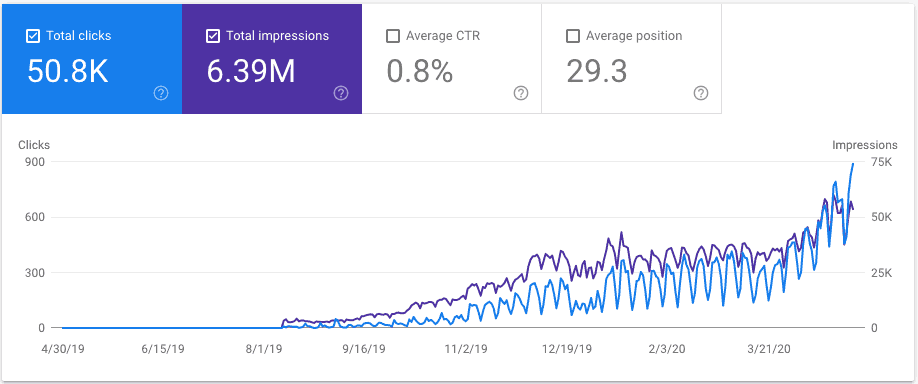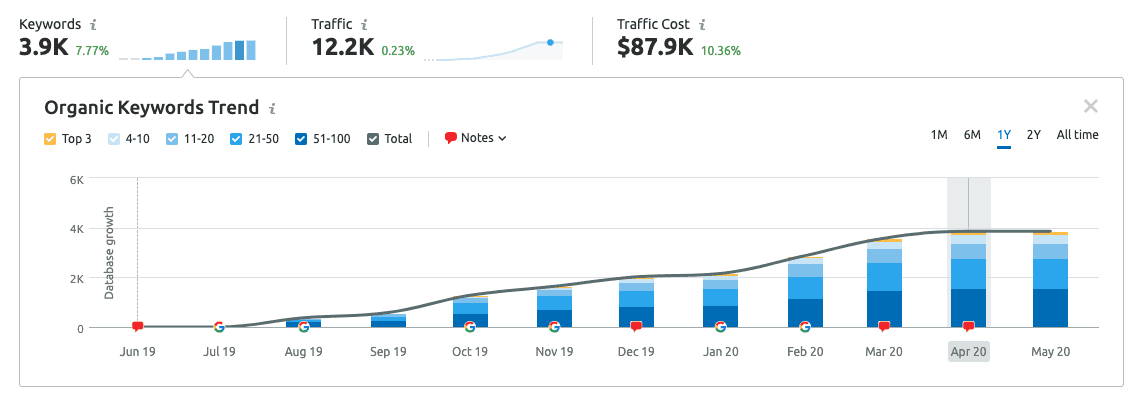Key points:
- CAC, or customer acquisition cost, is the cost of turning a user into a customer through purchasing your product or service.
- Customer lifetime value (LTV) is a forecast for the total profit attributed to the lifetime of a single customer.
- The LTV:CAC determines the scalability and sustainability of your marketing and operations growth strategy.
- The ideal LTV:CAC ratio should be 3:1 – meaning that the lifetime value of the customer should be worth three times more than the cost of acquiring them.
- Unlike paid advertising, you must continuously pay for traffic to generate leads MoM. Although it can be scalable as well, it just is not as economic as SEO.
- The difference is if you create a piece of content, and it starts converting and generating leads, you have paid a fixed cost on those leads, and the value extends past one month.
Classic “ROI for SEO” articles discuss metrics like traffic value, clicks, impressions, and conversions. These metrics are significant key performance indicators (KPIs) for successful SEO campaigns, but what do they tell us?
Simply, they refer to performance outside of what you have control over. But that doesn’t necessarily mean that these are the best success metrics (or how we call it, a North Star Metric or NSM).
So, how do you actually calculate the ROI of SEO?
For our software clients, we use a LTV:CAC model to determine ROI and growth efficiency.
What is CAC?
CAC, or customer acquisition cost, is the cost of turning a user into your customer as they purchase your product or service.
You can calculate CAC by dividing the total number of expenses associated with acquiring the customers by the number of new customers.
For example, here is a breakdown of some potential costs associated with SEO:
| Line Item | Cost |
| Cost of SEO Agency | $10,000.00 |
| Cost of Writing Content | $3,000.00 |
| Cost of Internal SEO Team | $10,000.00 |
| SEO Software | $2,000.00 |
| Total | $25,000.00 |
For all MQLs and customers generated, the underlying costs total to that $25,000. If you acquire 50 customers during this month and 200 MQLs, you can calculate cost-per-MQL and customer-acquisition-cost (CAC).
| Customer Acquisition Cost (CAC) | |
| Total cost to acquire all customers | $25,000 |
| Total new customers | 50 |
| MQLs | 200 |
| Close Rate | 50/200 = 25% |
| Cost per MQL | $25,000/200 = $125 |
| Customer Acquisition Cost (CAC) | $25,000/50 = $500 |
Now the biggest question here is, How do you determine that this cost of acquiring customers is sustainable and profitable?
This is where customer lifetime value (LTV) comes into play.
What is LTV?
Customer lifetime value (LTV) is a forecast for the total profit attributed to the lifetime of a single customer.
You can calculate LTV by taking the average order value (AOV) annualized and multiplying it by the gross margin (%), and then multiplying that by the lifespan of a customer based on a factor of 1.
For example, if you sell software at a rate of $200 per month, your annualized AOV should equal $2,400. Factoring in a gross margin of 52% and a lifespan of the customer of 1.25 years, here is a breakdown of the LTV calculation generated:
| Lifetime Value (LTV) | |
| Average Order Value Annualized: | $200 * 12 months = 2,400 |
| Gross Margin (GM%): | 52% |
| The lifespan of a customer: | 1.25 |
| Lifetime Value (LTV) | ($2,400 * 52%) * 1.25 = 1,560 |
LTV is then divided by CAC to determine the LTV:CAC ratio.
Understanding the impact of LTV:CAC
The LTV:CAC determines the scalability and sustainability of your marketing and operations growth strategy.
But how, exactly?
The ideal LTV:CAC ratio should be 3:1 – meaning that the lifetime value of the customer should be worth three times more than the cost of acquiring them. This leaves room for growth and reinvesting back into your business.
Having a LTV:CAC lower than 3:1 means that you are spending too much to acquire new customers, which could be detrimental to your business.
Adversely, a LTV:CAC higher than 3:1 could mean that you are missing out on potential customers and are not spending enough money to acquire new customers.
This ratio shows how efficient your marketing and sales activities are. By consistently dialing into this calculation, you improve your chances of growing your business overall.
Why is SEO so “low-cost”?
Search engine optimization has numerous one-time costs that provide long-term value. This is why SEO specialists continuously remind you to “think about it long-term”.
Ponder this situation:
Back in August of 2019, we created 100 articles for a SaaS client at a fixed cost of $10,000 ($100 per piece).
Since the inception of those articles, 50.8K clicks and 6.39M impressions have resulted.

If you took a look at the returns as of December 2019, you might be skeptical about the success of the content strategy. However, as of April 2020, it is much clearer of the impact of that initial $10,000 investment.
Based on our previous LTV:CAC model, the following would have to happen to reach the 3:1 ratio.
| Customer Acquisition Cost (CAC) | |
| Total cost to acquire all customers | $10,000 |
| Total new customers | 20 |
| MQLs | 100 |
| Close Rate | 20/100 = 25% |
| Cost per MQL | $10,000/100 = $105 |
| Customer Acquisition Cost (CAC) | $10,000/20 = $500 |
| Lifetime Value (LTV) | |
| Average Order Value Annualized: | $200 * 12 months = 2,400 |
| Gross Margin (GM%): | 52% |
| The lifespan of a customer: | 1.25 |
| Lifetime Value (LTV) | ($2,400 * 52%) * 1.25 = 1,560 |
| LTV:CAC Ratio | |
| LTV:CAC Ratio | $1,560 / $500 = 3.12 |
To be profitable, that content strategy only has to generate 20 new customers over the lifetime of the content generating traffic to the website. Let that sink in!
The difference?
If you create a piece of content and it starts converting and generating leads, you have paid a fixed cost on those leads. The value of that content extends past one month.
The value is additive.
To expand on this point, we looked at the keyword, traffic, and traffic cost of the content strategy in SEMrush.
As of April 2020, the traffic cost is $87.9K. That means that the cost of the traffic, if paid for through PPC advertising, is worth an estimated $87.9K per month.
In terms of traffic cost, we spent a fixed cost of $10,000 to generate organic traffic that would be worth $87.9K per month, and that traffic cost continues to add up month-over-month.
This could potentially add up to $1.054M in value (100x ROI, and counting).

Unlike paid advertising, you must continuously pay for traffic to generate leads month-over-month (MoM). Although it can be scalable as well, paid advertising is often just not as economical as SEO.
Lower risk, higher reward.
Scaling your SEO strategy
Unfortunately, like paid advertising, you cannot invest in SEO once and expect things to work out magically in your favor. SEO, like every other marketing channel, takes continuous implementation and improvement.
But, unlike paid advertising, you don’t have to spend vast amounts of money from month to month to scale your strategy.
Once you generate an SEO method that works, and you have determined that your LTV:CAC is at 3:1, you can continue to expand on your strategy and double down on what works.
For other examples of how we have scaled SaaS SEO campaigns, check out our case studies: SaaS Search Marketing Case Studies.
-
 CEO
Garrett Mehrguth
CEO
Garrett Mehrguth
Did you enjoy this article?
Share it with someone!
